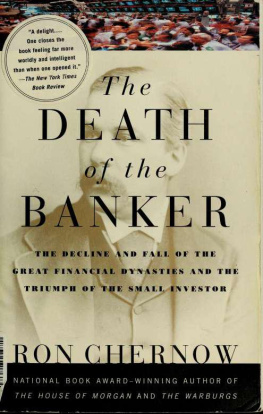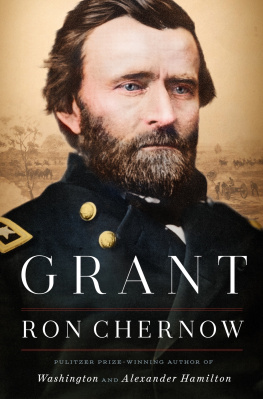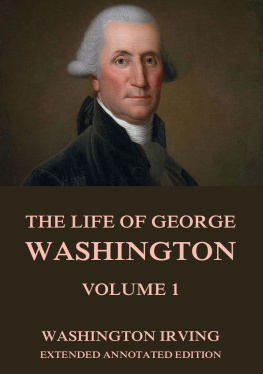Table of Contents
ALSO BY RON CHERNOW
Alexander Hamilton
Titan: The Life of John D. Rockefeller, Sr.
The Death of the Banker: The Decline and Fall of the
Great Financial Dynasties and the Triumph of the Small Investor
The Warburgs: The Twentieth-Century Odyssey of
a Remarkable Jewish Family
The House of Morgan: An American Banking Dynasty
and the Rise of Modern Finance
TO VALERIE, IN MEMORIAM
Simple truth is his best, his greatest eulogy.
ABIGAILADAMS, speaking of George Washington after his death
AUTHORS NOTE
Since I quote extensively from George Washingtons vast correspondence, I have taken the liberty of modernizing the spelling and punctuation of the eighteenth-century prose. A biographer hesitates to forfeit the special period flavor that comes from preserving all the oddities of contemporary writing. But all too often, Washingtons muscular style can seem awkward and stilted to modern readers because of the way he distributed his commas, for instance, whereas the writing suddenly becomes smooth and flowing with more familiar punctuation. Occasionally I retain the quirks of the original spelling in order to highlight the eccentricity or lack of education of the personality in question. Throughout the text, the actual wording has been exactly reproduced.
PRELUDE
The Portrait Artist
IN MARCH 1793 Gilbert Stuart crossed the North Atlantic for the express purpose of painting President George Washington, the supreme prize of the age for any ambitious portrait artist. Though born in Rhode Island and reared in New-port, Stuart had escaped to the cosmopolitan charms of London during the war and spent eighteen years producing portraits of British and Irish grandees. Overly fond of liquor, prodigal in his spending habits, and with a giant brood of children to support, Stuart had landed in the Marshalsea Prison in Dublin, most likely for debt, just as Washington was being sworn in as first president of the United States in 1789.
For the impulsive, unreliable Stuart, who left a trail of incomplete paintings and irate clients in his wake, George Washington emerged as the savior who would rescue him from insistent creditors. When I can net a sum sufficient to take me to America, I shall be off to my native soil, he confided eagerly to a friend. There I expect to make a fortune by Washington alone. I calculate upon making a plurality of his portraits... and if I should be fortunate, I will repay my English and Irish creditors.1 In a self-portrait daubed years earlier, Stuart presented himself as a restless soul, with tousled reddish-brown hair, keen blue eyes, a strongly marked nose, and a pugnacious chin. This harried, disheveled man was scarcely the sort to appeal to the immaculately formal George Washington.
Once installed in New York, Stuart mapped out a path to Washington with the thoroughness of a military campaign. He stalked Washingtons trusted friend Chief Justice John Jay and rendered a brilliant portrait of him, seated in the full majesty of his judicial robes. Shortly afterward Stuart had in hand the treasured letter of introduction from Jay to President Washington that would unlock the doors of the executive residence in Philadelphia, then the temporary capital.
As a portraitist, the garrulous Stuart had perfected a technique to penetrate his subjects defenses. He would disarm them with a steady stream of personal anecdotes and irreverent wit, hoping that this glib patter would coax them into self-revelation. In the taciturn George Washington, a man of granite self-control and a stranger to spontaneity, Gilbert Stuart met his match. From boyhood, Washington had struggled to master and conceal his deep emotions. When the wife of the British ambassador later told him that his face showed pleasure at his forthcoming departure from the presidency, Washington grew indignant: You are wrong. My countenance never yet betrayed my feelings!2 He tried to govern his tongue as much as his face: With me it has always been a maxim rather to let my designs appear from my works than by my expressions.3
When Washington swept into his first session with Stuart, the artist was awe-struck by the tall, commanding president. Predictably, the more Stuart tried to pry open his secretive personality, the tighter the president clamped it shut. Stuarts opening gambit backfired. Now, sir, Stuart instructed his sitter, you must let me forget that you are General Washington and that I am Stuart, the painter. To which Washington retorted drily that Mr. Stuart need not forget who he is or who General Washington is.4
A master at sizing people up, Washington must have cringed at Stuarts facile bonhomie, not to mention his drinking, snuff taking, and ceaseless chatter. With Washington, trust had to be earned slowly, and he balked at instant familiarity with people. Instead of opening up with Stuart, he retreated behind his stolid mask. The scourge of artists, Washington knew how to turn himself into an impenetrable monument long before an obelisk arose in his honor in the nations capital.
As Washington sought to maintain his defenses, Stuart made the brilliant decision to capture the subtle interplay between his outward calm and his intense hidden emotions, a tension that defined the man. He spied the extraordinary force of personality lurking behind an extremely restrained facade. The mouth might be compressed, the parchment skin drawn tight over ungainly dentures, but Washingtons eyes still blazed from his craggy face. In the enduring image that Stuart captured and that ended up on the one-dollar billa magnificent statement of Washingtons moral stature and sublime, visionary naturehe also recorded something hard and suspicious in the wary eyes with their penetrating gaze and hooded lids.
With the swift insight of artistic genius, Stuart grew convinced that Washington was not the placid and composed figure he presented to the world. In the words of a mutual acquaintance, Stuart had insisted that there are features in [Washingtons] face totally different from what he ever observed in that of any other human being; the sockets of the eyes, for instance, are larger than he ever met with before, and the upper part of the nose broader. All his features, [Stuart] observed, were indicative of the strongest and most ungovernable passions, and had he been born in the forests, it was his opinion that [Washington] would have been the fiercest man among the savage tribes. The acquaintance confirmed that Washingtons intimates thought him by nature a man of fierce and irritable disposition, but that, like Socrates, his judgment and great self-command have always made him appear a man of a different cast in the eyes of the world.5
Although many contemporaries were fooled by Washingtons aura of cool command, those who knew him best shared Stuarts view of a sensitive, complex figure, full of pent-up passion. His temper was naturally high-toned [that is, high-strung], but reflection and resolution had obtained a firm and habitual ascendency over it, wrote Thomas Jefferson. If ever, however, it broke its bonds, he was most tremendous in wrath.6 John Adams concurred. He had great self-command... but to preserve so much equanimity as he did required a great capacity. Whenever he lost his temper, as he did sometimes, either love or fear in those about him induced them to conceal his weakness from the world.7 Gouverneur Morris agreed that Washington had the tumultuous passions which accompany greatness and frequently tarnish its luster. With them was his first contest, and his first victory was over himself... Yet those who have seen him strongly moved will bear witness that his wrath was terrible. They have seen, boiling in his bosom, passion almost too mighty for man.8














